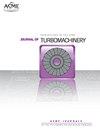IMPACT OF TEMPERATURE RATIO ON OVERALL COOLING PERFORMANCE: LOW-ORDER-MODEL-BASED ANALYSIS OF EXPERIMENT DESIGN
IF 3.1
3区 工程技术
Q3 ENGINEERING, MECHANICAL
引用次数: 0
Abstract
This paper describes low-order-model-based analysis of the design of an experiment to be used for parametric studies of adiabatic film and overall cooling effectiveness for fully cooled systems (internal and film) under wide ranges of mainstream-to-coolant temperature ratio variation, in the range 0.50 < T0m/T0c < 2.30. The purpose is to improve understanding of—and validation of—the scaling process from typical rig conditions to engine conditions. We are primarily interested in the variation in overall effectiveness when the controlling non-dimensional groups change in a natural co-dependent way with changes in temperature ratio: that is, the practical situation of interest to engine designers. We distinguish this from the situation in which individual non-dimensional groups are varied in isolation: a situation that we believe is essentially impossible to meaningfully approximate in practice, despite a body of literature purporting to do the same. Design and commissioning data from a new high temperature (600 K) test facility is presented, with detailed uncertainty analysis. We show that a typical nozzle guide vane which at engine conditions (TR = 2.00) would have overall cooling effectiveness of 0.450, would be expected to have overall effectiveness of 0.418 at typical rig conditions (TR = 1.20). That is, typical scaling from engine-to-rig result is −7.1%, and typical scaling from rig-to-engine is +7.7%, This result is important for first order estimation of overall cooling performance at engine conditions.温度比对整体冷却性能的影响:基于低阶模型的实验设计分析
本文描述了一个实验设计的低阶模型分析,该实验设计用于在主流与冷却剂温度比变化范围(0.50 < T0m/T0c < 2.30)的大范围内(内部和膜)绝热膜和整体冷却效率的参数研究。目的是提高对从典型钻机工况到发动机工况的换算过程的理解和验证。我们主要感兴趣的是,当控制的无量纲组以一种自然的相互依赖的方式随温度比的变化而变化时,整体效率的变化:也就是说,发动机设计者感兴趣的实际情况。我们将这种情况与个体无维度群体孤立变化的情况区分开来:我们认为这种情况基本上不可能在实践中有意义地近似,尽管有大量文献声称可以做到这一点。介绍了新型高温(600k)试验装置的设计和调试数据,并进行了详细的不确定度分析。我们表明,在发动机条件下(TR = 2.00),典型的喷嘴导叶的总体冷却效率为0.450,在典型的钻机条件下(TR = 1.20),预计其总体效率为0.418。也就是说,从发动机到钻机的典型比例为- 7.1%,而从钻机到发动机的典型比例为+7.7%。该结果对于发动机条件下整体冷却性能的一阶估计非常重要。
本文章由计算机程序翻译,如有差异,请以英文原文为准。
求助全文
约1分钟内获得全文
求助全文
来源期刊
CiteScore
4.70
自引率
11.80%
发文量
168
审稿时长
9 months
期刊介绍:
The Journal of Turbomachinery publishes archival-quality, peer-reviewed technical papers that advance the state-of-the-art of turbomachinery technology related to gas turbine engines. The broad scope of the subject matter includes the fluid dynamics, heat transfer, and aeromechanics technology associated with the design, analysis, modeling, testing, and performance of turbomachinery. Emphasis is placed on gas-path technologies associated with axial compressors, centrifugal compressors, and turbines.
Topics: Aerodynamic design, analysis, and test of compressor and turbine blading; Compressor stall, surge, and operability issues; Heat transfer phenomena and film cooling design, analysis, and testing in turbines; Aeromechanical instabilities; Computational fluid dynamics (CFD) applied to turbomachinery, boundary layer development, measurement techniques, and cavity and leaking flows.

 求助内容:
求助内容: 应助结果提醒方式:
应助结果提醒方式:


